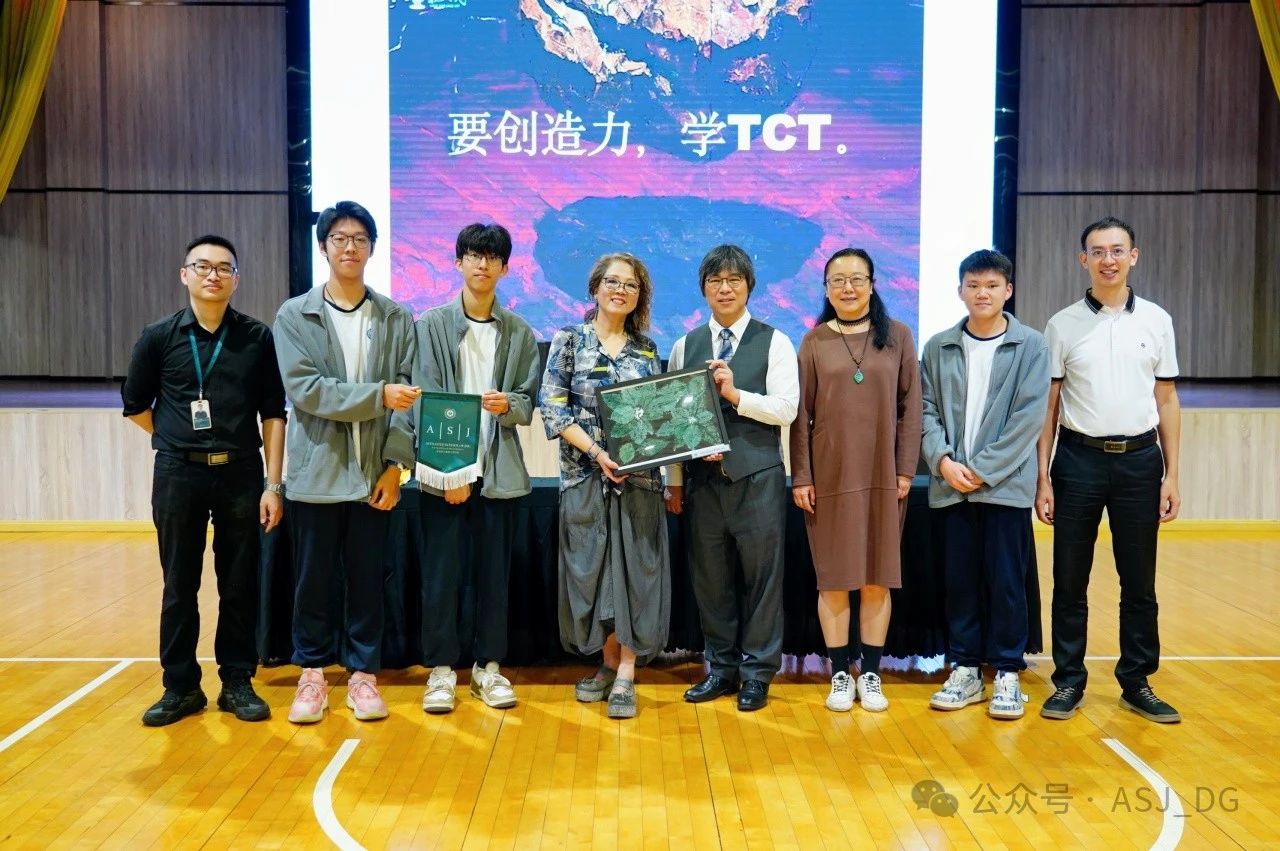学校地址:广东省东莞市高埗镇广场北路19号
学校邮箱: enquiry@asj-dg.com
招生电话: (+86)0769-88785333
邮政编码:523270
新闻活动
学 者 讲 堂
2024年05月28日

ASJ (Dongguan) was pleased to host the fourth Master Class of the Youth Arts Education Committee of the Guangdong Soong Ching Ling Foundation (GDSCLF) on 24 May. The Master Class this time included a special lecture - "What is the Purpose of Creative Education?" and an Intangible Cultural Heritage Workshop - "Making Cantonese Mahogany Chopsticks". The students deeply felt the charm of arts education in the above activities.
2024年5月24日下午,广东省宋庆龄基金会“美育公益课堂”学者讲堂第四讲在东莞暨大港澳子弟学校开讲。本次进入校园的公益项目有专题讲座——《创意教育,意欲为何》以及传统非遗手工课——“制作广式红木筷子”。本次公益课堂的讲座内容新颖、引人深思;非遗课堂底蕴深厚,考验技巧,学生们在以上活动中深刻感受到了艺术教育的魅力。

_________
Special Lecture -
"What is the Purpose of Creative Education?"
专题讲座:《创意教育,意欲为何》

In this special lecture, ASJ (Dongguan) was honoured to welcome Ms. Hong YANG, President of China Association for Children Arts and Deputy Director of Children Arts Committee of Guangdong Artists Association, to share with the students the educational philosophy of TCT (Training of Creative Thinking) and its importance for young students to cultivate creative thinking.
本次讲座东莞ASJ有幸迎来中国少年儿童造型艺术学会会长、广东省美术家协会少儿美术艺委会副主任杨红女士,为学生们分享TCT (Training of Creative Thinking/创意思维训练)的教育理念,及其对青少年培养创新思维的重要性。
During the lecture, Ms. YANG shared many innovative artworks and advertising cases based on everyday life. Through analysing these works, she explained to the students her educational philosophy, which is to "look at the things that others take for granted and think about the things that others have never thought about". To promote "TCT education", a new model of children's art education, Ms. YANG also shared some practical thinking training methods to guide students to pay attention consciously, think about things around them, and cultivate creative thinking skills.
杨红老师在讲座上分享了许多在日常情景基础上进行创新的艺术作品和广告案例,并通过对作品的解析向同学们传递自己在艺术领域的教育理念,即“看别人司空见惯的事物,想别人从未想过的问题”。杨红老师提倡“TCT教育”这一新颖的儿童艺术教育模式,并分享了几点切实可行的思维训练方法,旨在引导学生们有意识地留意和思考身边的事物,打破传统思维的桎梏,培养创新思维能力。


Ms. YANG also distributed a "creative fill in the blanks" paper to each student, encouraging them to use their imagination and draw on the paper, the students were inspired to create a piece of work full of creativity and personal style.
在活动现场,杨红老师还给同学们分发了一张“创意填空”纸张,鼓励同学们发挥想象力,尽情在纸上进行创作,同学们受到启发,纷纷进行创作,描绘出一幅幅充满创意且极具个人风格的作品。
At the end of the lecture, Ms. YANG encouraged students to "dare to think, be able to think, and be good at thinking", and said that only by breaking the rules can we think without constraints. Through Ms. YANG's sharing, the teachers and students in the audience gained valuable knowledge about arts education and opened up new perspectives in their daily lives.
最后,杨红老师鼓励同学们要“敢于想、能够想以及善于想”,她表示,只有勇于打破常规,思维才能不受束缚。通过杨红老师的分享,在场师生都收获了宝贵的艺术教育知识,还开辟了对日常生活进行二次思考的新思路。

_________
Intangible Cultural Heritage Workshop -
"Making Cantonese Mahogany Chopsticks"
非遗手工课堂:制作广式红木筷子

This time, the Intangible Cultural Heritage Workshop taught students the technique of making Cantonese mahogany chopsticks. The tutor for this session was Mr. Xihua LIU, a designer from Gengsuantang Classical Furniture Co., Ltd. and the representative inheritor of the Cantonese Hardwood Furniture Making Technique, an Intangible Cultural Heritage project in Liwan District of Guangzhou.
在本期非遗手工课堂上,学生们学习了制作广式红木筷子的技艺,本次的授课讲师是耕酸堂古典家具有限公司设计师、广州市荔湾区非物质文化遗产项目广式硬木家具制作技艺代表性传承人刘锡桦先生。
Before making the chopsticks, Mr. LIU first introduced the students to the characteristics of the woodwork of the three different regions of China (Beijing, Jiangsu and Guangdong). He taught them how to distinguish the different styles of woodwork. Mr. LIU then gave a detailed introduction to the origin of Chinese chopsticks, the etiquette of use and the production process. With a basic understanding of the theory, the students were excited to start making chopsticks.
在正式动手制作前,刘先生首先向学生们讲解了中国三大传统流派(京作、苏作、广作)的木作特点,教导同学们如何分辨不同风格的木作。随后,刘先生对中华筷子的起源、使用礼仪以及制作流程进行了详细介绍。在对理论知识有了一定程度的了解后,学生们摩拳擦掌,兴奋地开启了筷子制作。

Under guidance, the students used pencils, rulers, files and other tools to sharpen the mahogany material into the shape of chopsticks. The students then had to use different grits of sandpaper to polish the chopsticks repeatedly, removing small imperfections and making the surface smooth. The whole process was a test of patience for the students, who had to make comparisons between 2 chopsticks and repeat the process to create a pair of chopsticks with their own efforts.
学生们在指导下使用铅笔、尺子、马牙锉等工具将红木材料挫圆挫方,直至材料呈现出“天圆地方”的筷子雏形;接下来,学生们还要使用不同目数的砂纸对筷子进行反复打磨,去除细小的瑕疵,使之变得光滑。整个过程十分考验学生们的耐心,他们需要左右比对、反复加工,才能制作出一双倾注自己情感和劳动的筷子。

This experience not only exercised the students' hands-on ability but also allowed them to gain new knowledge about Guangdong's intangible cultural heritage and further appreciate the charm of Chinese craftsmanship.
这次学习,不仅锻炼了学生们动手实践的能力,还让他们吸收到了许多广作非遗文化的知识,更进一步感悟了“工匠精神”的魅力。


学校地址:广东省东莞市高埗镇广场北路19号
学校邮箱: enquiry@asj-dg.com
招生电话: (+86)0769-88785333
邮政编码:523270